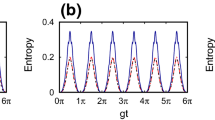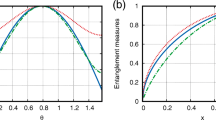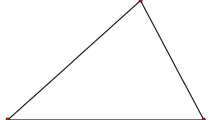Abstract
We investigate the advantages of extracting the degree of entanglement in bipartite systems directly from tomograms, as it is the latter that are readily obtained from experiments. This would provide a superior alternative to the standard procedure of assessing the extent of entanglement between subsystems after employing the machinery of state reconstruction from the tomogram. The latter is both cumbersome and involves statistical methods, while a direct inference about entanglement from the tomogram circumvents these limitations. In an earlier paper, we had identified a procedure to obtain a bipartite entanglement indicator directly from tomograms. To assess the efficacy of this indicator, we now carry out a detailed investigation using two nonlinear bipartite models by comparing this tomographic indicator with standard markers of entanglement such as the subsystem linear entropy and the subsystem von Neumann entropy and also with a commonly used indicator obtained from inverse participation ratios. The two-model systems selected for this purpose are a multilevel atom interacting with a radiation field, and a double-well Bose–Einstein condensate. The role played by the specific initial states of these two systems in the performance of the tomographic indicator is also examined. Further, the efficiency of the tomographic entanglement indicator during the dynamical evolution of the system is assessed from a time-series analysis of the difference between this indicator and the subsystem von Neumann entropy.













Similar content being viewed by others
References
Ekert, A.K., Alves, C.M., Oi, D.K.L., Horodecki, M., Horodecki, P., Kwek, L.C.: Direct estimations of linear and nonlinear functionals of a quantum state. Phys. Rev. Lett. 88, 217901 (2002). https://doi.org/10.1103/PhysRevLett.88.217901
Horodecki, P., Ekert, A.: Method for direct detection of quantum entanglement. Phys. Rev. Lett. 89, 127902 (2002). https://doi.org/10.1103/PhysRevLett.89.127902
Bovino, F.A., Castagnoli, G., Ekert, A., Horodecki, P., Alves, C.M., Sergienko, A.V.: Direct measurement of nonlinear properties of bipartite quantum states. Phys. Rev. Lett. 95, 240407 (2005). https://doi.org/10.1103/PhysRevLett.95.240407
Blume-Kohout, R., Yin, J.O.S., van Enk, S.J.: Entanglement verification with finite data. Phys. Rev. Lett. 105, 170501 (2010). https://doi.org/10.1103/PhysRevLett.105.170501
Li, X., Shang, J., Ng, H.K., Englert, B.G.: Optimal error intervals for properties of the quantum state. Phys. Rev. A 94, 062112 (2016). https://doi.org/10.1103/PhysRevA.94.062112
Rohith, M., Sudheesh, C.: Signatures of entanglement in an optical tomogram. J. Opt. Soc. Am. B 33, 126 (2016). https://doi.org/10.1364/JOSAB.33.000126. URL http://josab.osa.org/abstract.cfm?URI=josab-33-2-126
Laha, P., Lakshmibala, S., Balakrishnan, V.: Estimation of nonclassical properties of multiphoton coherent states from optical tomograms. J. Mod. Opt. 65, 1466 (2018). https://doi.org/10.1080/09500340.2018.1454527
Rohith, M., Sudheesh, C.: Visualizing revivals and fractional revivals in a Kerr medium using an optical tomogram. Phys. Rev. A 92, 053828 (2015). https://doi.org/10.1103/PhysRevA.92.053828
Sharmila, B., Saumitran, K., Lakshmibala, S., Balakrishnan, V.: Signatures of nonclassical effects in optical tomograms. J. Phys. B: At. Mol. Opt. 50, 045501 (2017). https://doi.org/10.1088/1361-6455/aa51a4
Yu, T., Eberly, J.: Sudden death of entanglement. Science 323, 598 (2009)
Laha, P., Sudarsan, B., Lakshmibala, S., Balakrishnan, V.: Entanglement dynamics in a model tripartite quantum system. Int. J. Theor. Phys. 55, 4044 (2016)
Viola, L., Brown, W.G.: Generalized entanglement as a framework for complex quantum systems: purity versus delocalization measures. J. Phys. A: Math. Theor. 40, 8109 (2007). URL http://stacks.iop.org/1751-8121/40/i=28/a=S17
Brown, W.G., Santos, L.F., Starling, D.J., Viola, L.: Quantum chaos, delocalization, and entanglement in disordered Heisenberg models. Phys. Rev. E 77, 021106 (2008). https://doi.org/10.1103/PhysRevE.77.021106
Buccheri, F., De Luca, A., Scardicchio, A.: Structure of typical states of a disordered Richardson model and many-body localization. Phys. Rev. B 84, 094203 (2011). https://doi.org/10.1103/PhysRevB.84.094203
Giraud, O., Martin, J., Georgeot, B.: Entropy of entanglement and multifractal exponents for random states. Phys. Rev. A 79, 032308 (2009). https://doi.org/10.1103/PhysRevA.79.032308
Giraud, O., Martin, J., Georgeot, B.: Entanglement of localized states. Phys. Rev. A 76, 042333 (2007). https://doi.org/10.1103/PhysRevA.76.042333
Beugeling, W., Andreanov, A., Haque, M.: Global characteristics of all eigenstates of local many-body Hamiltonians: participation ratio and entanglement entropy. J. Stat. Mech. 2015, P02002 (2015). URL http://stacks.iop.org/1742-5468/2015/i=2/a=P02002
Dukesz, F., Zilbergerts, M., Santos, L.F.: Interplay between interaction and (un)correlated disorder in one-dimensional many-particle systems: delocalization and global entanglement. New J. Phys. 11, 043026 (2009). URL http://stacks.iop.org/1367-2630/11/i=4/a=043026
Karthik, J., Sharma, A., Lakshminarayan, A.: Entanglement, avoided crossings, and quantum chaos in an Ising model with a tilted magnetic field. Phys. Rev. A 75, 022304 (2007). https://doi.org/10.1103/PhysRevA.75.022304
Lakshminarayan, A., Srivastava, S.C.L., Ketzmerick, R., Bäcker, A., Tomsovic, S.: Entanglement and localization transitions in eigenstates of interacting chaotic systems. Phys. Rev. E 94, 010205 (2016). https://doi.org/10.1103/PhysRevE.94.010205
Kannawadi, A., Sharma, A., Lakshminarayan, A.: Persistent entanglement in a class of eigenstates of quantum Heisenberg spin glasses. EPL 115, 57005 (2016). URL http://stacks.iop.org/0295-5075/115/i=5/a=57005
Sanz, L., Moussa, M., Furuya, K.: Generation of generalized coherent states with two coupled Bose–Einstein condensates. Ann. Phys. (N.Y.) 321, 1206 (2006). https://doi.org/10.1016/j.aop.2005.09.003. URL http://www.sciencedirect.com/science/article/pii/S0003491605001569
Agarwal, G.S., Puri, R.R.: Collapse and revival phenomenon in the evolution of a resonant field in a Kerr-like medium. Phys. Rev. A 39, 2969 (1989). https://doi.org/10.1103/PhysRevA.39.2969
Mistakidis, S., Katsimiga, G., Kevrekidis, P., Schmelcher, P.: Correlation effects in the quench-induced phase separation dynamics of a two species ultracold quantum gas. New J. Phys. 20, 043052 (2018)
Gross, C., Strobel, H., Nicklas, E., Zibold, T., Bar-Gill, N., Kurizki, G., Oberthaler, M.: Atomic homodyne detection of continuous-variable entangled twin-atom states. Nature 480, 219 (2011)
Smithey, D.T., Beck, M., Raymer, M.G., Faridani, A.: Measurement of the Wigner distribution and the density matrix of a light mode using optical homodyne tomography: application to squeezed states and the vacuum. Phys. Rev. Lett. 70, 1244 (1993). https://doi.org/10.1103/PhysRevLett.70.1244
Vogel, K., Risken, H.: Determination of quasiprobability distributions in terms of probability distributions for the rotated quadrature phase. Phys. Rev. A 40, 2847 (1989). https://doi.org/10.1103/PhysRevA.40.2847
Ibort, A., Man’ko, V.I., Marmo, G., Simoni, A., Ventriglia, F.: An introduction to the tomographic picture of quantum mechanics. Phys. Script. 79, 065013 (2009). URL http://stacks.iop.org/1402-4896/79/i=6/a=065013
Lvovsky, A.I., Raymer, M.G.: Continuous-variable optical quantum-state tomography. Rev. Mod. Phys. 81, 299 (2009). https://doi.org/10.1103/RevModPhys.81.299
Weigert, S., Wilkinson, M.: Mutually unbiased bases for continuous variables. Phys. Rev. A 78, 020303 (2008). https://doi.org/10.1103/PhysRevA.78.020303
Sudheesh, C., Lakshmibala, S., Balakrishnan, V.: Manifestations of wave packet revivals in the moments of observables. Phys. Lett. A 329, 14 (2004). https://doi.org/10.1016/j.physleta.2004.06.085. URL http://www.sciencedirect.com/science/article/pii/S0375960104009132
Biswas, A., Agarwal, G.S.: Nonclassicality and decoherence of photon-subtracted squeezed states. Phys. Rev. A 75, 032104 (2007). https://doi.org/10.1103/PhysRevA.75.032104
Abarbanel, H.D.I.: Analysis of Observed Chaotic Data. Springer, New York (1996)
Grassberger, P., Procaccia, I.: Characterization of strange attractors. Phys. Rev. Lett. 50, 346 (1983). https://doi.org/10.1103/PhysRevLett.50.346
Abarbanel, H.D.I., Brown, R., Kennel, M.B.: Local Lyapunov exponents computed from observed data. J. Nonlinear Sci. 2, 343 (1992). https://doi.org/10.1007/BF01208929
Hegger, R., Kantz, H., Schreiber, T.: Practical implementation of nonlinear time series methods: the TISEAN package. Chaos 9, 413 (1999)
Bartkiewicz, K., Černoch, A., Lemr, K., Miranowicz, A.: Priority choice experimental two-qubit tomography: measuring one by one all elements of density matrices. Sci. Rep. 6, 19610 (2016)
Opatrný, T., Welsch, D.G.: Density-matrix reconstruction by unbalanced homodyning. Phys. Rev. A 55, 1462 (1997). https://doi.org/10.1103/PhysRevA.55.1462
Brida, G., Genovese, M., Gramegna, M., Traina, P., Predazzi, E., Olivares, S., Paris, M.: Toward a full reconstruction of density matrix by on/off measurements. Int. J. Quant. Inf. 7, 27 (2009)
Lvovsky, A.: Iterative maximum-likelihood reconstruction in quantum homodyne tomography. J. Opt. B: Quant. Semiclass. Opt. 6(6), S556 (2004)
Acknowledgements
One of the authors (SL) thanks M. Santhanam of IISER Pune for discussions pertaining to inverse participation ratios.
Author information
Authors and Affiliations
Corresponding author
Additional information
Publisher's Note
Springer Nature remains neutral with regard to jurisdictional claims in published maps and institutional affiliations.
Appendices
Appendix 1: Reconstructing a single-mode vacuum state from the tomogram
For our present purpose, we start with the tomogram for a zero-photon state obtained numerically from the corresponding density matrix. The aim is to demonstrate how to reconstruct the state from this tomogram. Since we have the exact density matrix (equivalently, state) to compare it with, we can assess the efficiency of the reconstruction program. The procedure we employ is based on iterative maximum likelihood estimates. Here, starting with a trial density matrix, an appropriate transformation outlined in [40] is applied iteratively on the density matrix to achieve a reconstructed state with the maximum possible likelihood of being the true state (here, the vacuum state). It is evident that the choice of the trial state is crucial for the efficiency of this procedure. Figure 14a–c shows the different reconstructed states arising from three different trial density matrices. Figure 14d is the photon number distribution of the true state. It is evident that Fig. 14c is closer to the true state compared to Fig. 14a, b. However, the probability of the zero-photon state is only \(\sim 0.85\) compared to 1 in Fig. 14d.
Photon number distribution of the reconstructed state corresponding to trial density matrix a \(0.1\sum _{p=0}^{9} |p\rangle \langle p|\), b \(0.2\sum _{p=0}^{4} |p\rangle \langle p|\) and c \(0.9 |0\rangle \langle 0| + 0.1 |1\rangle \langle 1|\). d Photon number distribution of the true state \(|0\rangle \langle 0|\)
More sophisticated techniques will lead to a reconstructed state closer to the zero-photon state. However, these are computationally intensive even in this case and significantly more time-consuming for bipartite and multipartite states. It is therefore useful and efficient to extract as much information about a state directly from tomograms as possible.
Appendix 2: Time evolution in the double-well BEC model
The double-well BEC effective Hamiltonian is given by Eq. (24). We require the state \(|\psi (t)\rangle \) corresponding to an initial state that is a direct product of normalized boson-added coherent states of the atoms in the wells A and B, namely,
where \(\alpha _{a}, \alpha _{b} \in \mathbb {C}\) and \(m_{1}, m_{2}\) are nonnegative integers. The dependence of the state on \(\alpha _{a}\) and \(\alpha _{b}\) has been suppressed on the left-hand side for notational simplicity. The m-PACS \(|\alpha , m\rangle \) [defined in Eq. (17)] reduces to the standard oscillator coherent state \(|\alpha \rangle \) for \(m = 0\).
In the special case \(m_{1} = 0, m_{2} = 0\), the state at any time t corresponding to the initial state \(\psi _{0,0}(0)\) has been shown in Ref. [22] to be given by
where
and \(\lambda _{1}=(\lambda ^{2}+ \omega _{1}^{2})^{1/2}\). It can then be shown [9] that the state vector at time t is given by
where the operator \(M_{m_{1},m_{2}}(t)\) is as follows. Let k, l, p, q denote nonnegative integers, and let
Further, let
and \(\Gamma =\cos ^{-1}(\omega _{1}/\lambda _{1})\). Then
Rights and permissions
About this article
Cite this article
Sharmila, B., Lakshmibala, S. & Balakrishnan, V. Estimation of entanglement in bipartite systems directly from tomograms. Quantum Inf Process 18, 236 (2019). https://doi.org/10.1007/s11128-019-2352-0
Received:
Accepted:
Published:
DOI: https://doi.org/10.1007/s11128-019-2352-0





